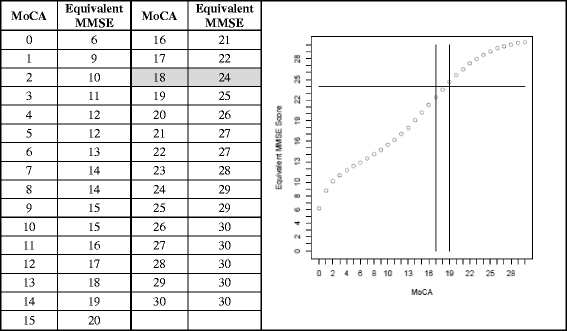Relationship between the Montreal Cognitive Assessment and Mini-mental State Examination for assessment of mild cognitive impairment in older adults
- PMID: 26346644
- PMCID: PMC4562190
- DOI: 10.1186/s12877-015-0103-3
Relationship between the Montreal Cognitive Assessment and Mini-mental State Examination for assessment of mild cognitive impairment in older adults
Abstract
Background: The Montreal Cognitive Assessment (MoCA) was developed to enable earlier detection of mild cognitive impairment (MCI) relative to familiar multi-domain tests like the Mini-Mental State Exam (MMSE). Clinicians need to better understand the relationship between MoCA and MMSE scores.
Methods: For this cross-sectional study, we analyzed 219 healthy control (HC), 299 MCI, and 100 Alzheimer's disease (AD) dementia cases from the Alzheimer's Disease Neuroimaging Initiative (ADNI)-GO/2 database to evaluate MMSE and MoCA score distributions and select MoCA values to capture early and late MCI cases. Stepwise variable selection in logistic regression evaluated relative value of four test domains for separating MCI from HC. Functional Activities Questionnaire (FAQ) was evaluated as a strategy to separate dementia from MCI. Equi-percentile equating produced a translation grid for MoCA against MMSE scores. Receiver Operating Characteristic (ROC) analyses evaluated lower cutoff scores for capturing the most MCI cases.
Results: Most dementia cases scored abnormally, while MCI and HC score distributions overlapped on each test. Most MCI cases scored ≥ 17 on MoCA (96.3%) and ≥ 24 on MMSE (98.3%). The ceiling effect (28-30 points) for MCI and HC was less using MoCA (18.1%) versus MMSE (71.4%). MoCA and MMSE scores correlated most for dementia (r = 0.86; versus MCI r = 0.60; HC r = 0.43). Equi-percentile equating showed a MoCA score of 18 was equivalent to MMSE of 24. ROC analysis found MoCA ≥ 17 as the cutoff between MCI and dementia that emphasized high sensitivity (92.3%) to capture MCI cases. The core and orientation domains in both tests best distinguished HC from MCI groups, whereas comprehension/executive function and attention/calculation were not helpful. Mean FAQ scores were significantly higher and a greater proportion had abnormal FAQ scores in dementia than MCI and HC.
Conclusions: MoCA and MMSE were more similar for dementia cases, but MoCA distributes MCI cases across a broader score range with less ceiling effect. A cutoff of ≥ 17 on the MoCA may help capture early and late MCI cases; depending on the level of sensitivity desired, ≥ 18 or 19 could be used. Functional assessment can help exclude dementia cases. MoCA scores are translatable to the MMSE to facilitate comparison.
Figures



References
-
- Spencer RJ, Wendell CR, Giggey PP, Katzel LI, Lefkowitz DM, Siegel EL, et al. Psychometric limitations of the Mini-mental State Examination among nondemented older adults: an evaluation of neurocognitive and magnetic resonance imaging correlates. Exp Aging Res. 2013;39(4):382–97. doi: 10.1080/0361073X.2013.808109. - DOI - PubMed
Publication types
MeSH terms
Grants and funding
LinkOut - more resources
Full Text Sources
Other Literature Sources
Medical

